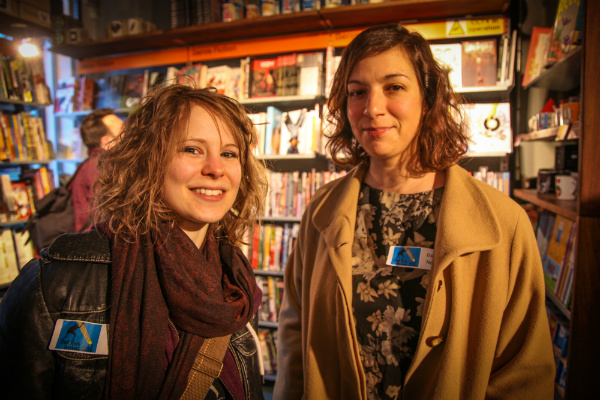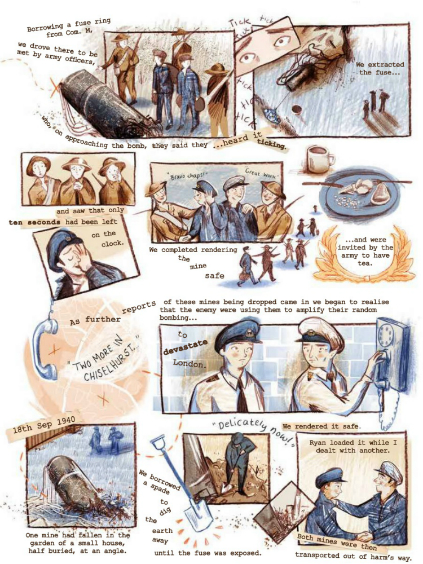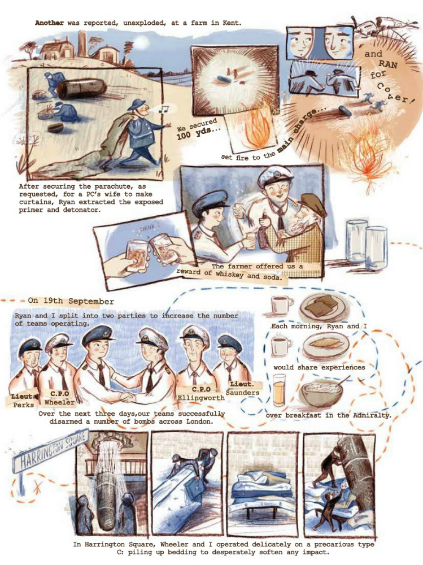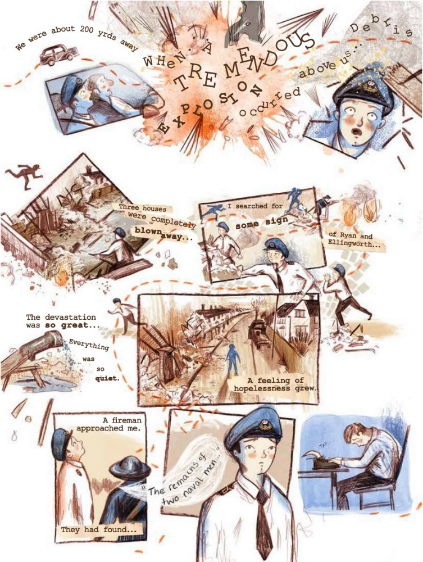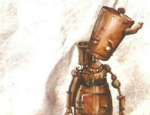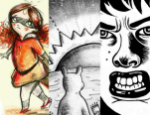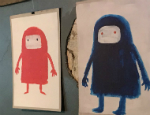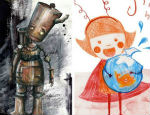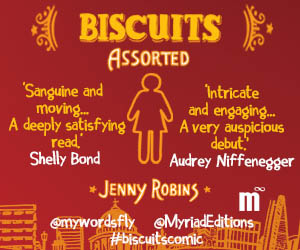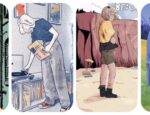
If you’re reading this article then the chances are high that you’re already an advocate of the unique storytelling power of biographical comics – that powerful ability to so empathetically immerse the reader in the lives of their subjects and to communicate their experiences with a richly rewarding clarity. Earlier this autumn the work of one of our Broken Frontier ‘Six Small Press Creators to Watch in 2016‘ artists Rebecca Bagley went on display at the Museum of London Docklands with just such an aim in mind.
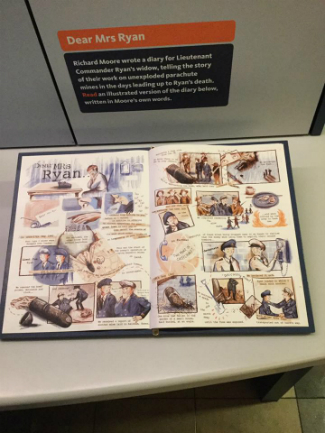 Bagley’s Dear Mrs. Ryan – a six-page comic that now makes up part of the museum’s permanent collection – was created to complement the display of a rare George Cross medal awarded to Richard V. Moore and recounts Moore’s bomb disposal exploits during the Blitz in the Second World War alongside his colleagues Lieutenant-Commander Dick Ryan and Chief Petty Officer Reginald Ellingworth.
Bagley’s Dear Mrs. Ryan – a six-page comic that now makes up part of the museum’s permanent collection – was created to complement the display of a rare George Cross medal awarded to Richard V. Moore and recounts Moore’s bomb disposal exploits during the Blitz in the Second World War alongside his colleagues Lieutenant-Commander Dick Ryan and Chief Petty Officer Reginald Ellingworth.
Its focus is on engaging a younger audience with his story but, like so many of Rebecca Bagley’s comics to date, it has that particular quality so notable in her work of being a genuinely all-ages offering – one that children and adults alike will interact with on different levels.
When it comes to selecting creators for Broken Frontier’s ‘Six to Watch’ initiatives the main thing I look for is artists who understand how to use the unique storytelling tricks of the comics form to foster an emotional connection with their readership that enhances the impact of the themes of their narratives. That prerequisite could not be more in evidence than it is in Dear Mrs. Ryan wherein Bagley shows just how far her grasp of the medium has come since her debut longer-form comic Tick a few years back.
The Museum of London Docklands have shared three pages from the comic with us below and Bagley’s pure craft shines through in all of them. Her tight yet scattered page layouts, for example, build a sense of tension throughout via their placement of panels within panels, overlapping imagery and displaced lettering that all works together to emphasise the drama of the situation.
Her visual characterisation is accessible without ever patronising its audience and forgetting the depth of the subject matter, and the movement of characters in and out of panels has a meta quality that demonstrates her profound understanding of the language of sequential art. A beautifully paced comic and one that is well worth making a trip to the museum to see in its entirety. It’s also refreshing to see the medium being adopted as a communication tool in a perhaps non-traditional environment.
Rebecca Bagley (left) at the Broken Frontier Small Press Yearbook and Broken Frontier Anthology launch night at London’s Gosh! Comics earlier this year…
Here’s the full press release for the exhibit at the Museum of London Docklands:
On the night of 16 September 1940, near the beginning of the London Blitz, the German forces began to drop naval mines for the first time over London. Many failed to explode and created an imminent threat to the safety of Londoners. Richard V Moore was one of the naval staff who volunteered to make these mines safe. From the period of 17 to 21 September, Moore, along with Lieutenant-Commander Dick Ryan and Chief Petty Officer Reginald Ellingworth, travelled across London, Essex and Kent defusing these unexploded mines to make them safe.
On 21 September 1940, Moore, Ryan and Ellingworth were called to Dagenham to defuse three German mines. Whist Moore tackled a mine outside a factory, Ryan and Ellingworth headed to neutralise a mine hanging from a roof in North Oval Road. Tragically, the mine exploded, killing both men. All three men were awarded the George Cross, Ryan and Ellingworth posthumously, for ‘great gallantry and undaunted devotion to duty’. Only 12 George Cross medals had been directly awarded prior to Moore’s.
Moore’s George Cross medal will form part of the new display which will be housed within the Docklands at War gallery, set to open on 21 September to commemorate the gallant story of these men. As part of a new initiative the museum has introduced to make the collection more engaging for families, this will be an interactive display with a graphic novel and 3D puzzle that will make this heroic, historical story relatable to children.
Vyki Sparkes, Curator of Social and Working History at the museum, said: “This important display allows the museum to recognise the bravery of some of those who volunteered to disable bombs and mines during the London Blitz. The efforts of Moore and his team saved countless lives, homes and allowed factories and airfields to continue their vital war work.”
Thanks go to the Moore family for their generosity in donating this prestigious award to the museum.
This also seemed the ideal opportunity to talk to Rebecca about Dear Mrs. Ryan and her creative process when approaching the book…
All images (c) Rebecca Bagley. Click to enlarge.
ANDY OLIVER: How did you first become involved with the project?
REBECCA BAGLEY: My lovely agent lined me up for it. It was a really nice wildcard for both of us because she’s actually my literary agent, so the work I do with her is solely in the publishing and book domain. Working with the Museum was a quirky one off she’d picked up on her travels and, serendipitously, I’d been discussing the idea of doing more comic book work with her that week. It was one of those projects that seemed a little bit made for me!
She sent the museum my recent comic shorts and, luckily, they seemed to agree it was a decent fit too!
What is it about the comics form that makes it such an appropriate one for communicating this story especially, in this instance, to a potentially younger audience?
The museum had received the donation of the George Cross Medal, original letters and manuscripts of Moore’s journal from his family. These remarkable, first hand accounts were a fascinating window into the reality of WWII bomb disposal teams, and the Museum knew they wanted to give the public that insight. But they were pages and pages long and the curators knew that that much text alone, plonked on a wall would rarely be fully read, especially by kids.
They wanted to shorthand the text, but to edit it alone felt a little impertinent, and would likely have resulted in the small, enriching details of the story being lost. Converting the tale into a comic was a brave move on their part, to shorthand the story while still retaining as much information as possible. I relied a lot on the images to create the world that had been described in the journal for people to become absorbed in, while using Moore’s voice to move on the chain of events. I like illustrated stories for this quality of a dual purpose narrative and hope that it’s worked as a way of keeping the story concise, while retaining the richness of Moore’s original words.
Given the diary nature of the source material you were working with can you tell us a little about the page design decisions you made in adapting Richard Moore’s words to a different medium?
It was a pretty daunting job to be honest! I tried to avoid using my own words and, instead, extracted Moore’s in a manner I felt kept the story moving. We’d discussed comic length and there was very little leeway to go over so it was always going to be a tight manoeuvre! I knew that the conclusion of the tale deserved a full and impactful flow and the curators and I had discussed in length the importance of keeping the emotional tone of the journal intact.
I liked the idea of framing the journal within one of the letters Moore had written as it acted as bookends to the story, leading the audience into the journal’s events and setting the pace and tone of the comic. That, naturally, added additional information to include in the short page count, but it seemed important to me in setting a steady pace to begin with so that I could set up the relationships. Having done this, I felt I could then change the final spread in its layout to alter the pace of the story and achieve maximum impact. The chaos of this spread was vital to me in communicating the incomprehensible emotion of Moore’s concluding entries.
Your use of colour is very distinctive in Dear Mrs. Ryan. What was the thinking behind that mix of blues and sepia tones?
I do prefer to keep palettes limited in comics to allow the details to breathe. When choosing artists, the Museum had run focus groups in which a series of comic artists had been presented to children and adults. The feedback showed that the limited palettes of my work had been popular so the Museum were keen to keep this. Also it seemed strange to present a humbling tale with a full palette of primary colours. It seemed like a more delicate approach would be more appropriate in tackling the subject matter.
I drew up several palettes and the sepia/naval blue/orange seemed to fit. Moore and his team were apart of the Naval units, so the blue was a reflection of this. The oranges offered a contrast and suggested drama and action without the hard violence of a red. I then used the transition of blue heavy to orange heavy spreads to communicate the tone of the spreads; calmer scenes through to more dramatic compositions.
Considering the nature of the story you were illustrating how much of an added sense of responsibility was there in bringing it to a short comics format?
Huge. The Museum were so brave in believing the story could translate into a whole new format and I am honoured to have been entrusted with it!
It’s an enormous task to edit another person’s words without undermining their tale, especially one of such a delicate nature. And then to add imagined but loyal pictorial reference too was even more pressure!
The Museum team were brilliant, they gave me as much historical and social information as they could so I could get a feel for the time and after that they trusted me fully. I never felt creatively restricted working with them, they allowed me full access to tell the story as the manuscripts had inspired me to do so, while still offering advice and suggestions when they felt it may be suitable. It was nerve-wracking knowing that Moore’s family would only see the comic in its entirety, but everyone was supportive of the format and I only hope I did Moore’s incredible tale the justice it deserves.
Full details on the collections at the Museum of London Docklands can be found here.
For more on the work of Rebecca Bagley visit her site here and follow her on Twitter here. Her online store can be found here for comics and here for Christmas cards.
Rebecca Bagley is also a contributor to the Broken Frontier Small Press Yearbook, available to order online here priced just £6.00 plus postage.
For regular updates on all things small press follow Andy Oliver on Twitter here.





